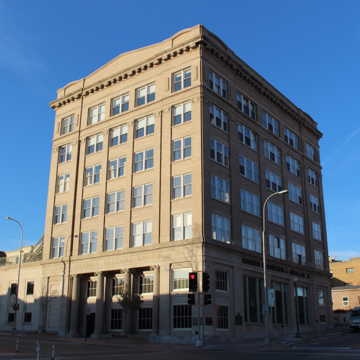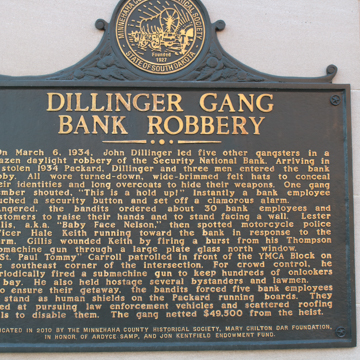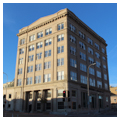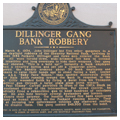You are here
Historic Security National Bank Building
The Security Building is located in downtown Sioux Falls on the southwest corner of Main Avenue and Ninth Street. It is one of few examples of early-twentieth-century commercial architecture surviving in the downtown core.
The Security National Bank of Sioux Falls opened for business in 1890 as the Northwest Security National Bank; it reorganized as the State Bank and Trust Company, before becoming the Security National Bank in 1914. The building was designed as the bank’s headquarters, and provided office space for Sioux Falls’s rapidly expanding professional and business community.
The restrained Classical Revival building was designed by the Chicago architectural firm E. Jackson Casse Company. The seven-story structure was the first in Sioux Falls to be built with a steel skeleton. The curtain walls on the lowest two floors are clad in Bedford stone on the north and east facades; the upper floors, also on the north and east sides, are clad in gray brick with limestone trim. The walls on the west and south, facing the alley and neighboring building, have a red-brick veneer. On the building’s east side, four inset composite columns supporting an unornamented entablature define the main entrance, which gave access to a two-story banking hall and one of several vaults located within the building. It was in this classically ornamented hall that FBI Public Enemy No. 1 John Dillinger and his gang of machine-gun wielding accomplices made off with $50,000 on March 6, 1934.
Over the years, a number of other banks consolidated with and were absorbed by the Security National Bank. In 1935, the name was again changed to the Northwest Security National Bank. When Northwest Security’s office needs outgrew the original building, the bank erected two modest additions on the south side. The first, completed in 1951, was a simple, two-story, stone-clad extension whose cornice and bays followed the pattern of the original building. The second, completed in 1957, consisted of a single-story commercial block with four storefronts and customer parking on a roof that also included a drive-in bank.
In 2007, Legacy Real Estate completed a renovation of the building, converting the upper floors into luxury apartments and opening additional space for professional and business offices. This renovation is one of many ongoing redevelopment efforts in downtown Sioux Falls.
References
Olson, Dr. Gary. “Security Bank Building,” Minnehaha County, South Dakota. National Register of Historic Places Inventory-Nomination Form, 1984. National Park Service, U.S. Department of the Interior, Washington, D.C.
Smith, Charles A. A Comprehensive History of Minnehaha County, South Dakota. Mitchell, SD: Educator Supply Company, 1949.
Writing Credits
If SAH Archipedia has been useful to you, please consider supporting it.
SAH Archipedia tells the story of the United States through its buildings, landscapes, and cities. This freely available resource empowers the public with authoritative knowledge that deepens their understanding and appreciation of the built environment. But the Society of Architectural Historians, which created SAH Archipedia with University of Virginia Press, needs your support to maintain the high-caliber research, writing, photography, cartography, editing, design, and programming that make SAH Archipedia a trusted online resource available to all who value the history of place, heritage tourism, and learning.













